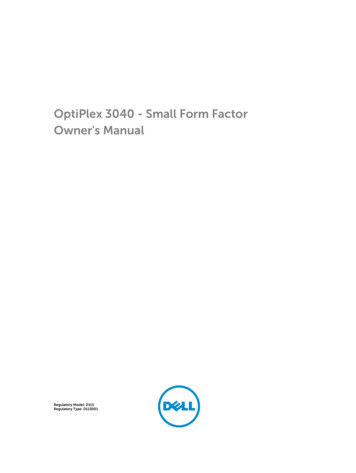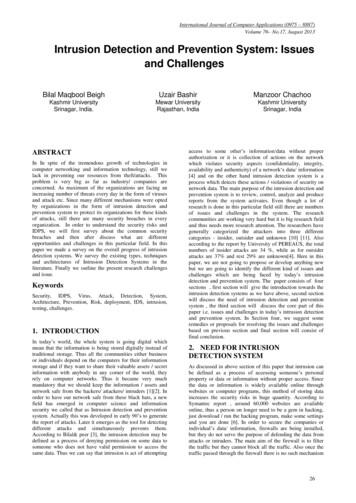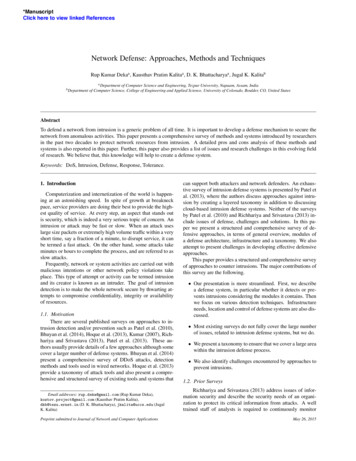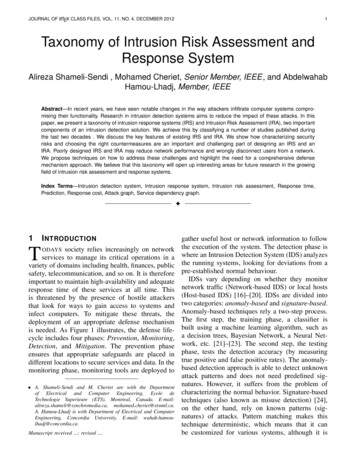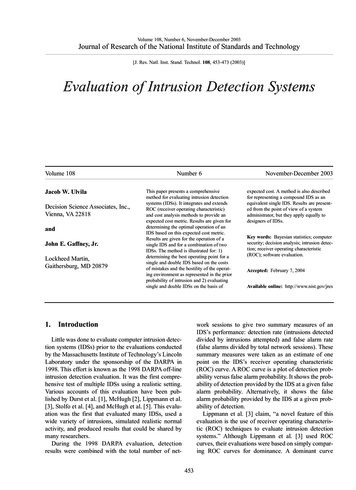
Transcription
BIJIT - BVICAM’s International Journal of Information TechnologyBharati Vidyapeeth’s Institute of Computer Applications and Management (BVICAM), New Delhi (INDIA)Framework for Choosing Best Intrusion Detection SystemBilal Maqbool BeighSubmitted in February, 2014; Accepted in November, 2014Abstract - As there are many intrusion detection systems The Computer Emergency Response Team (CERT) reportedavailable in the market and yet there is not a single guideline 3734 incidents in 1998, 9859 in 1999 and 8836 in the first 6framed by any researcher or any organization so that a months of 2000. In a recent audit of U.S. federal agencies bycompany or an organization will decide which intrusion the GAO [4] investigators were able to pierce security at nearlydetection system is best suited to their company for the every system they tested. The cause of these attacks are eitherpurpose of security. Here in this paper, we have proposed a complexity of the system itself or increasing number of hackersnovel guideline in terms of framework for choosing right day by day or market competitors or software developmentmost intrusion detection system for an organization. The companies itself etc. Therefore along with these tremendousframework needs some security expert so that they can check opportunities for sharing important information and resourceespecially used for some critical operation like military , space,the equation to be satisfied.nuclear etc. It has become very much important to protect theseIndex Terms – Framework, Guideline, model, IDS, Intrusion. special and important resources and information against suchattacks [5]. For protecting the same, we have the concept called“Information security” thus we can say that information1.0 INTRODUCTIONThe story of the human life started with Stone Age, then security is such area which protects our information / resourcesagriculture age and now we are in the information technology from theft or misuse. But still this field of research is in itsage, where everything depends upon information and infancy days. This research started in early 90’s and so far littleinformation processing systems. Information ranging from has been done in this field. This research field comprises ofpersonnel to commercial have been processed and exchanged many subfield such as system side security, network sideby these information systems. With the advent of Internet, the security etc. One subset of information security that has beenconvergence of information & communication technologies the area of much more attention in recent years is intrusionand today’s very complex nature of business environment detection system [5]. Therefore intrusion detection system canresulted in myriad trust and information security concerns. The be defined as the process of monitoring events occurring in asecure functioning of these information systems is the utmost system and signaling responsible parties when interestingimportant and foremost concern. Information security is a field (suspicious) activity (compromises the confidentiality,of security which ensures the confidentiality, integrity and integrity, availability, or to bypass the security mechanisms ofavailability of information and information processing a computer or network) occurs [7]. At this instant of time, thereresources. Many security professionals think that developing a are many intrusions detection systems available in market withcompletely secure system is almost an impossible task. different features and uses, but it is very difficult for a user orAccording to [1] the completely secure system is one that is organization to choose best Intrusion detection system for himdisconnected from a network, encased in concrete, and lying at or for his organization [8][14]. As there is no such guidelinethe bottom of the ocean. In this networked environment where provided by any agency/ organization to choose the securitythere are potential number of hackers and adversaries present, policy therefore there is a need of guidelines for the purpose.security enforcing mechanisms needs to be incorporated in the Here In this research work, we will provide a framework ininformation systems to with stand with the both deliberate and terms of mathematical equations and steps for choosing bestaccidental malicious intents. Hence this tremendous growth in possible intrusion detection system for you and yourcommunication technology brings number of good things to organization. This part will ensure that the system for intrusionhuman society, but it also makes us re-lay on information detection should be made in accordance to the model preparedsystems [2].As the information is increasing in digital format in terms of equations and physical model to be described in theday by day, the vulnerabilities are also increasing in the form of next sections of this paper.cyber threats, attacks and mis-identification of trusted users.There are lots of intrusion attacks in today’s digital world, 2.0 NEED FOR FRAMEWORK FOR CHOOSING IDSaccording to recent survey by CERT/CC [3], the rate of The intrusion detection system allows us to make the systemintrusion attacks almost doubles every year.safe from the most attackers. Thus as described in previous andthis chapter, intrusion can be defined as a process of accessingsomeone’s personal property or data or information withoutP. G. Department of Computer Sciences, University of proper access or proper authentication cardinalities. As all of usKashmir, Jammu and Kashmir, INDIAknow that today’s almost 90 percent of information is availableE-mail: bilal.beigh@gmail.comonline through websites or computer programs. Although thismake very ease and very fast access to the people overall theCopy Right BIJIT – 2015; January - June, 2015; Vol. 7 No. 1; ISSN 0973 – 5658821
BIJIT -BVICAM’s International Journal of Information Technologyglobe, but it also increases the risk to the maximum. Accordingto Symantec report, around 1, 00,000 websites are availableonline and some of them share the critical information andvaluable data. In order to steal the critical data or important andrelevant information without having legitimate access to theresources, the person on longer need not to be a hacking gem,just download and run the hacking program, make somesettings and you are done [9][16]. In order to secure thecompanies or individual’s data/ information, firewalls are beinginstalled, but they alone do not serve the purpose of defendingthe data from attacks or intruders. The main aim of the firewallis to filter the traffic but they cannot block all the traffic. Alsoonce the traffic passed through the firewall there is no suchmechanism available that traffic will be monitored inside thenetwork for rest processing. Also firewall only detects externaltraffic coming to it, but doesn’t detect the internal attacks. Byusing intrusion detection system, we can monitor or do thefollowing things: Monitors network traffic. Continuously monitors servers/ network for misuse actionsor abuse policy. Attack / breach alerting, response and reporting. Countermeasures.Thus it became very much important for an organization toinstall both firewall and intrusion detection system to securetheir assets / information for hackers / attackers. Also forsecuring this particular data and information from the attackers,there are lots of intrusion detection mechanisms currentlyavailable in the market. Every intrusion detectionmanufacturing organization highlights his qualities of makingsecure the information, but none of the organization or researchcommunity describes the guidelines for picking the mostappropriate and good suitable intrusion detection system forany company or individual. Thus it became very muchimportant to provide some guidelines either through somemodel or through some mathematical formula to suggest thecompany which intrusion detection system is most suited forthem and under which norms. We have taken a step towards thedevelopment of guidelines for choosing the right intrusiondetection in accordance to their requirements and importance’s.In this chapter we have presented guidelines for choosing rightmost intrusion detection system for company or individualunder required condition. The guidelines will be discussed innext section of this chapter.3.0 FRAME WORK FOR CHOOSING INTRUSIONDETECTION SYSTEMChoosing an intrusion detection system is a delicate task, as thewhole company security responsibility lies on the shoulders ofthe intrusion detection system i.e.to detect the attack made onthe organization system, to mitigate them if possible or to alertthe administrator about the attack happened [4]. Currently thereare many intrusion detection systems available within themarket but it is difficult to choose the best intrusion detectionsystem for an organization[17]. In order to choose the same, wehave devised a framework that will help an organization tochoose the best intrusion detection. The framework consists oflogical steps and which when followed revealed the desiresintrusion detection system. The steps which are involved inchoosing best intrusion detection are as: Risk Analysis. Detection Rate False Alarm Rate Cost Benefit analysis Updates or patches ratio.When the above mentioned steps are followed in a mannershown in figure below (cc), yield the results based on themathematical formulas. The accepted criteria must be decidedby the security professionals to choose best intrusion detectionsystem.Identify RiskPick IDSDetection RateTrue AlarmSelect anotherChoice ofCost BenefitIDSUpdates AvailableIfSatisfiedYoursFigure 1: Frame Work for choosing right intrusiondetection system3.1 Risk AnalysisThe Risk analysis step is the first step towards the choosing ofintrusion detection and prevention system for an individual oran organization. This step is most important and criticaltowards the picking of right most intrusion detection system.The risk calculation is very big thing to do because it dealswith the overall security of the organization. The risk analysiscan be considered as a tool for risk management, which ishelpful for identifying security issues i.e. vulnerabilities,threats and unauthorized access. Also as per the generaldefinition of risk on different blogs and websites, the risk canbe calculated as:“Risk Threats x Vulnerabilities x Impact”Copy Right BIJIT – 2015; January - June, 2015; Vol. 7 No. 1; ISSN 0973 – 5658822
Framework for Choosing Best Intrusion Detection SystemBut we have devised the risk in accordance to our ownformulas. The formula will depend upon the following factors.i. Summation of threats.ii. Value / impact of threatsiii. Total Impact of assets under riskiv. Total assets of the organization.Before enforcing the formula, The RAG (Risk Analysis Group)will find two important aspects used in making the formulawhich are [10] [11] [12] [13]: Identifying important information and their Values Identifying threats and Vulnerabilities for the assetsIdentifying important information and their Values –Identifying the values of the organization’s importantinformation is the very first step for risk analysis. In this stepthe risk assessment group will point out / identify the mostimportant assets of organization and will estimate the costassociated and damage resulted if some intrusion/ attackhapped on an organization or we can say the group will analyzethe loss made by losing the information to some othercompany. While identifying the assets following things must bekept in consideration. Cost of assets/ information that may be lost if intrusionhappen. Role and usage of assets / information.Identifying threats and Vulnerabilities –After pointing outthe important information/assets, the responsibility of the groupis to identify the vulnerabilities and threats for assets/ importantinformation as identified in the prior step. Also they have tokeep an order of threats i.e. which threat may damage/ theftmore information according to the percentage of damage doneby these threats and vulnerabilities. Thus in general, the RAGwill gather the information about the loss of assets /information in total at the initial stage, if not prevented andtotal threats and vulnerabilities that can cause these losses.After acquiring the above two steps, we have derived a formulawhich we are going to use to calculate the risk is as under:By calculating the estimated risk, we can have idea about howmuch it will affect our assets. Therefore the overall percentageof the risk can be calculated with the help of the followingformula.After getting the results of assets under risk in percentage, wewill move towards the next step of the frame work.IDs etc. Before going for any products, the company shouldconsider all the available resources for basic system operationand maintenance. Thus should be able to pick the appropriateIDS which will meet the needs within the constraints laid downby company. This task is very difficult, As there is no industrystandard against which we will compare IDS. Hence there is aneed of providing a standard benchmark for IDS. The newproduct cycle for commercial IDSs is rapid, and informationand systems quickly become obsolete. Steven Northcuttrecommends the use of product guides that are updated at leastmonthly. Relatively little objective third party evaluation ofIDSs is available, while trade press reports are generally spottyand superficial. Setting up a facility to objectively compareIDSs will be prohibitively expensive for all but the largestpotential users, and some third-party or industry sponsoredeffort is needed. Marketing literature rarely describes how wella given IDS finds intruders and how much work is required touse and maintain that system in a fully functioning networkwith significant daily traffic. IDS vendors usually specifywhich prototypical attacks their systems can find, but withoutaccess to deployment environments, they cannot describe howwell their systems detect real attacks while avoiding falsealarms. Edward Amoroso and Richard Kwapniewski recentlyprovided guidance in selecting IDS [14] by making somequestionnaires, upon the receiving the answers from the users,they will choose the intrusion detection system. Theseguidelines have impact of bias towards a particular intrusiondetection system. This step is very important, as it is concernwith the security of overall system. The step choice based andwill not be entertained in the conditions which are going todecide that is the picked intrusion detection system the rightmost intrusion detection for their organization. The decision ofthis step lies on the shoulders of the Risk analysis group. Theyare the security professionals which will decide the most suitedas per the threats and vulnerability of the organizations.3.3 Detection RateThe step is very much important as the decision is concerned.The detection rate for a particular intrusion detection systemwill be available in the literature and papers available indifferent research journals. Let us make an example, in one ofour experiment, the snort has detection rate of 99.4 % whichmeans that 99.4% of attacks are being detected by the snortcoming towards the system. Similarly all intrusion detectionhas the documentation, which shows the rate of detection forthat intrusion detection system. Rate of detection can becalculated as:Or we can say that the rate of detection can be calculated as:3.2 Picking of IDSEvery organization wants to secure their confidential resources,for that they have to make some selection in terms of firewalls,Copy Right BIJIT – 2015; January - June, 2015; Vol. 7 No. 1; ISSN 0973 – 5658823
BIJIT -BVICAM’s International Journal of Information TechnologyTP amount of attack when it actually attackTN amount of normal detect when it actually normalAlso rate of detection can be calculated using the aboveformula. The detection rate is very much important as perselection is concerned. It shows the overall rate. If the detectionrate is greater than 90 %, the system is partially accepted.Which means the system will be evaluated for the next section.i.e. True alarm Rate .3.4 True Alarm RateThe step is much important as per the decision is concerned. Aswe are calculating the rate of false positive alarm rate whichcan be calculated as the ratio of in-correct classified intrusionsto the total number of normal records. Therefore false positiverate (FPR) can be calculated as:But we have to calculate the True Positive alarm rate which canbe derived as from the above formula, which can be derived asbelow:True Positive Rate 100- false Positive RateLet us assume we got the false positive rate as 3.06% , then wecan easily get the true positive rate as 96.77% which means thatthe system is accurately identifying 96.77 % of the intrusionsthat of total available in the dataset. Upon partial accepted fromprevious sections. If the true alarm rate is less than 95 %, it ispartially accepted.3.5 Cost Benefit Analysis.There is a variety of approaches to cost analysis, the suitabilityof any of which depends upon the purpose of an assessmentand the availability of data and other resources. It is rarelypossible or necessary to identify and quantify all costs and allbenefits (or outcomes), and the units used to quantify thesemay differ.Main types of cost analysis include the following. Cost-of-illness analysis: a determination of the economicimpact of an illness or condition (typically on a givenpopulation, region, or country) e.g., of smoking, arthritis orbedsores, including associated treatment costs Cost-minimization analysis: a determination of the leastcostly among alternative interventions that are assumed toproduce equivalent outcomes. Cost-effectiveness analysis (CEA): a comparison of costsin monetary units with outcomes in quantitative nonmonetary units, e.g., reduced mortality or morbidity. Cost-utility analysis (CUA): a form of cost-effectivenessanalysis that compares costs in monetary units withoutcomes in terms of their utility, usually to the patient,measured, e.g., in QALYs. Cost-consequence analysis: a form of cost-effectivenessanalysis that presents costs and outcomes in discretecategories, without aggregating or weighting them. Cost-benefit analysis (CBA): compares costs and benefits,both of which are quantified in common monetary units.Before a company or an organization decides on exactly whichIDS that organization or company should opt, it is veryimportant to perform cost/ benefit analysis. As it is veryobvious and important that cost/benefit analysis is very real andimportant factor in decision making of all the process related toan organization. There funds allocated to the security or othersolutions have to have a good reason why such funds areallocated to the said solution. This analysis can be performedeffectively once the organizations risk analysis has beenperformed. This risk analysis will give the organization a veryreal sense of the costs associated company assets. Theestimated cost/ benefit of the company can be evaluated withthe following formulas as shown under:The equation of cost has been designed to evaluate the totalcost of the security solution for an organization. The costconsists of all the man power which can be used to incorporatethe security solution in accordance to the requirement of theorganization for the purpose of securing the critical data. Alsothe benefit is as important as determine the cost of securitysolution. The benefit will give us figures that whether thesolution will be beneficial to the company. It will give us theimpact of the benefits using the big budget for the securitysolution. The formula helps us to estimate the benefits from thesecurity solution, which is usually the cost of assets which arecurrently under threat and future assets. The formulas forbenefits are as under:Where n is the number of AssetsThe Net Cost-Benefit will be retrieved from the difference ofcost from benefits. The Net-cost benefit analysis will bederived as under:This section will be critical as far as the decision will be isconcerned. If partially accepted from last sections, if the NetCost Benefits is greater than Zero ( 0), it is again partiallyaccepted.3.6Decision PhaseThis is one of the most important phases of our framework, ifthe system is already partially accepted; it will go to the nextCopy Right BIJIT – 2015; January - June, 2015; Vol. 7 No. 1; ISSN 0973 – 5658824
Framework for Choosing Best Intrusion Detection Systemphase of detection. The final selection results will be based onthe following points:Name of 1. Highest rate of detection under consideration.2. Lowest False alarm Rate.3. Highest Net-Cost Benefit.It is considered that if the one security solution has high NetCost-Benefits rate and rest two options are low and othersolution have also been partially accepted but does not haveNet Cost-Benefits but have very good statistics high indetection rate and true positive rate, the security solutionswhich have high detection rate and true positive rate will beconsidered for selection.Table1: Detection Rate for evaluationName of IDSDetection RateSnortBroNIDS98.3 %94.4 %97.3%As per the statistics available in the literature, Snort has highestdetection rate while on the second number NIDS is there andBro is at the third number.False Rate: As per the literature available, we have collectedthe respective false rate of the all the three intrusion detectionsystem available mentioned above. The False rate is as under:Table 2: False alarm Rate for evaluationName of IDSSnortBroNIDSFalse Rate2.3%7.5%2.1%4.0 EVALUATION OF FRAMEWORK FOR CHOOSINGINTRUSION DETECTION SYSTEMThe evaluation of frame work for choosing Intrusion detectionsystem was done on the statistics provided by the Kashmiruniversity IT&SS department. The department provided thestatistics only meant for the research meant in this thesis. Thefigures provided are as :As per the statistics available in the literature, NIDS have leastfalse rate, on second number Snort is there and last is Bro.Cost-Benefit:The benefit of all the three is as follows:Risk Analysis: As per the departmental report, total cost ofassets which are under risk (attacks). The risk figures arecalculated by using the above mentioned formulas.The costs of all the three are:Cost of Snort Cost of Deployment Cost of updating Cost Maintenance.Risk Cost of Results Cost of pay generation Software Cost of E-GovernanceRisk 10,00,000 2,00,000 50,00000Risk 62,00,000 ( Approx).Pick IDS: We have chosen three intrusion detection systemswhich are open source. The selection of intrusion detection isbased on statistics and popularity score in literature available.The intrusion detection systems are:1. Snort.2. Bro3. NIDS.Detection Rate: As per the literature available, we havecollected the detection rate of the all the three intrusionTable3: Cost Benefit for evaluationCost of Snort 1, 00,000 (purchasing of Computer) 0 30,000(rule purchasing) 1, 30,000.Cost of Bro Cost of Deployment Cost of updating Cost Maintenance (Script writing).Cost of Bro 1, 00,000(purchasing of Computer) 10,000per Month 40000(Script Writing) 1, 50,000.Cost of NIDS Cost of Deployment Cost of Updating Cost of MaintenanceName of IDSCostSnort1,30,000Bro1,50,000Cost of NIDS 1, 00,000(purchasing of Computer) 50,000per Month 20,000Cost of NIDS 1, 70,000NIDS1,70,000Table 4: Cost for evaluationdetection system available. The detection rate is as under:Table5: Net Cost Benefit for evaluationNet Cost-Benefit Benefit – CostCopy Right BIJIT – 2015; January - June, 2015; Vol. 7 No. 1; ISSN 0973 – 5658825
BIJIT -BVICAM’s International Journal of Information TechnologyName of IDSSnortBroNIDSNet Cost-Benefit62,00,000-1,30,000 607000062,00,000- 1,50,000 605000062,00,000 -1,70,000 6030000Decision:As the Net Cost-Benefit analysis for all are almost same,therefore the deciding factor is now detection rate and falsealarm rate. As per the calculation Snort has highest detectionrate from the three and rate of false alarm rate for snort is 2.3and NIDS is 2.1. Therefore after seeing the results, thedetection rate of Snort is high and false rate is almost same inNIDS and Snort, so we choose Snort from all the threeintrusion detection system.4.0 CONCLUSIONThe current research is focused on choosing intrusion detectionand prevention system. The selection of the Intrusion detectionSystem is a very tough job. The thesis chapter provideframework for choosing best intrusion detection system for anorganization. The framework is the form of flow diagram,when followed strictly will yield a solution for choosing bestintrusion detection and prevention system for an organization.The steps mentioned in framework appears to be a simpleexercise but are basically important/ critical steps for gettingbest of ID&PS for an organization . But ultimately the choicedepends upon company. The researcher had made an attempt toprovide certain guidelines in terms of frame work for choosingor selecting right most intrusion detection for an organization.5.0 ACKNOWLEDGEMENTI would like to thank Prof. S. M. K. Quadri, Head, Departmentof Computer Sciences, University of Kashmir for helping methroughout the course- Thank you Sir6.0 REFERENCES[1]. CONNOLLY, P. J., 2001. Security protects bottom line.InfoWorld, Vol. 23, No. 15, p. 47[2]. SAKURAI, K., & Kim, T. H. (2008). A Trend in IDSresearches. (Journal of Security Engineering), 5(4), 8.[3]. Lazarevic, A., Ertoz, L., Kumar, V., Ozgur, A., &Srivastava, J. (2003). A comparative study of anomalydetection schemes in network intrusion detection. Proc.SIAM.[4]. Mathew, D. (2002). Choosing an intrusion detectionsystem that best suits your organization. GSEC Practicalv1.4b,availableat:www.Sans.org/reading room/whitepapers/detection[5]. Brown, D. J., Suckow, B., & Wang, T. (2002). A surveyof intrusion detection systems. Department of ComputerScience, University of California, San Diego.[6]. Grandison, T., &Terzi, E. (2009). Intrusion ].[14].[15].[16].Beigh, B. M., & Peer, M. A. (2011). Intrusion Detectionand Prevention System: Classification and Quick.Kovacich, G. L. (2003). The Information SystemsSecurity Officer's Guide: Establishing and managing n.Huang, Y. A., & Lee, W. (2003, October). Acooperative intrusion detection system for ad hocnetworks. In Proceedings of the 1st ACM workshop onSecurity of ad hoc and sensor networks (pp. 135-147).ACM.Cavusoglu, H., Mishra, B., &Raghunathan, S. (2004). Amodel for evaluating IT security investments.Communications of the ACM, 47(7), 87-92.Banerjee, U., & Arya, K. V. (2013). OptimizingOperating Cost of an Intrusion Detection System.International Journal of Communications, Network andSystem Sciences, 6(1).Cohen, G., Meiseles, M., &Reshef, E. (2012). U.S.Patent No. 8,099,760. Washington, DC: U.S. Patent andTrademark OfficeAmoroso, E., &Kwapniewski, R. (1998, December). Aselection criteria for intrusion detection systems. InComputer Security Applications Conference, 1998.Proceedings. 14th Annual (pp. 280-288). IEEE.Chaudhary, A., V. N. Tiwari, and A. Kumar. "Analysisof fuzzy logic based intrusion detection systems inmobile adhoc networks." BIJIT – BVICAM’sInternational Journal of Information Technology, 6.1(2014): 690-696.Beigh, Bilal Maqbool. "One-stop: A novel hybrid modelfor intrusion detection system." INDIACom - 2014,2014 IEEE International Conference on Computing forSustainable Global Development, Bharati Vidyapeeth’sInstitute of Computer Applications and Management(BVICAM). New Delhi, 2014.Mitra, Sulata, and Arkadeep Goswami. "Load Balancingin Integrated MANET, WLAN and Cellular Network."BIJIT – BVICAM’sInternational Journal ofInformation Technology, (2011): 304.Copy Right BIJIT – 2015; January - June, 2015; Vol. 7 No. 1; ISSN 0973 – 5658826
by the security professionals to choose best intrusion detection system. Pick IDS. Figure 1: Frame Work for choosing right intrusion detection system . 3.1 Risk Analysis The Risk analysis step is the first step towards the choosing of intrusion detection and prevention system for an individual or an organization. This step is most important and .


